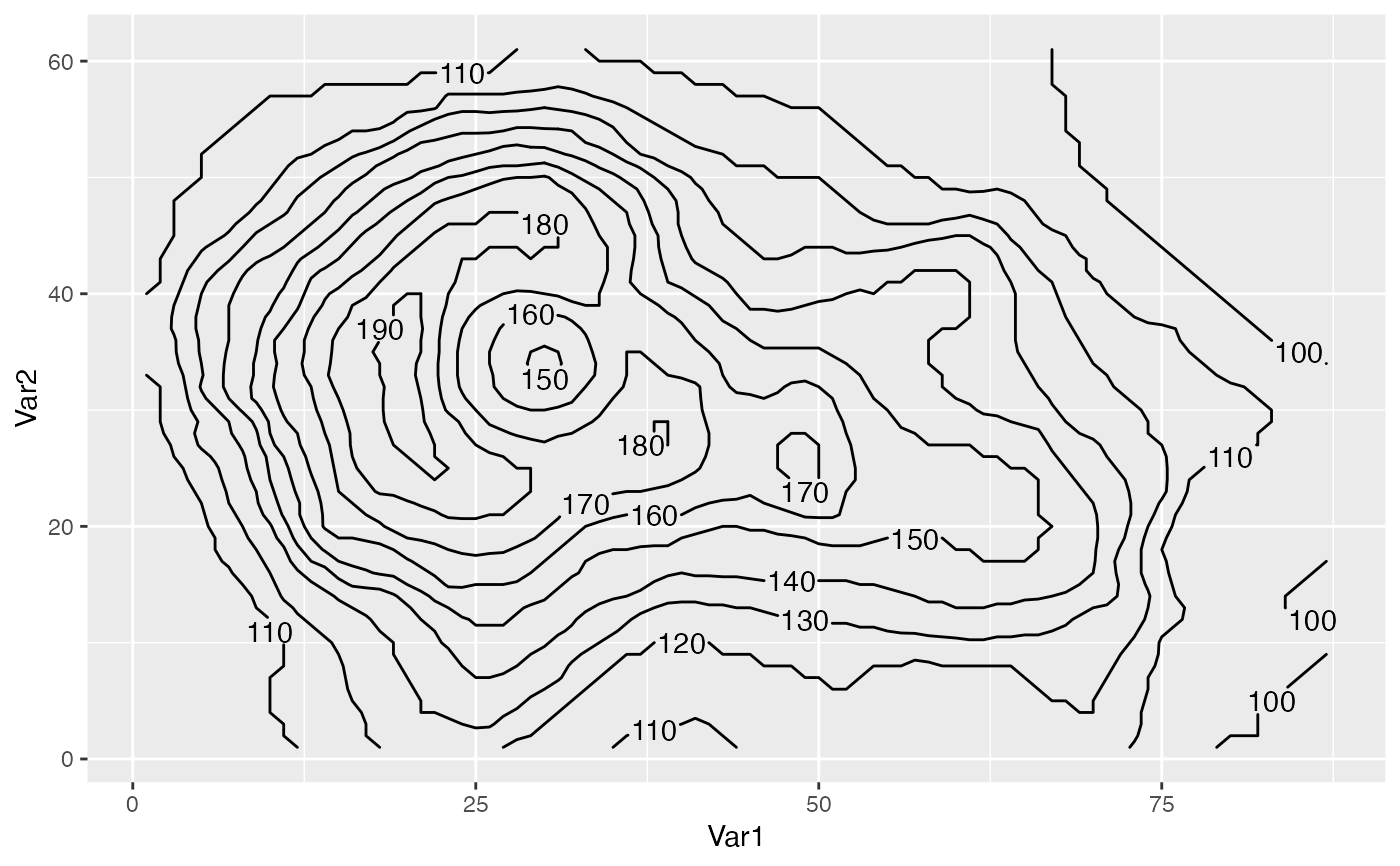Similar to ggplot2::geom_contour but it can label contour lines,
accepts accepts a function as the breaks argument and and computes
breaks globally instead of per panel.
geom_contour2(
mapping = NULL,
data = NULL,
stat = "contour2",
position = "identity",
...,
lineend = "butt",
linejoin = "round",
linemitre = 1,
breaks = MakeBreaks(),
bins = NULL,
binwidth = NULL,
global.breaks = TRUE,
na.rm = FALSE,
na.fill = FALSE,
skip = 1,
margin = grid::unit(c(1, 1, 1, 1), "pt"),
label.placer = label_placer_flattest(),
show.legend = NA,
inherit.aes = TRUE
)
stat_contour2(
mapping = NULL,
data = NULL,
geom = "contour2",
position = "identity",
...,
breaks = MakeBreaks(),
bins = NULL,
binwidth = NULL,
kriging = FALSE,
global.breaks = TRUE,
na.rm = FALSE,
na.fill = FALSE,
show.legend = NA,
inherit.aes = TRUE
)Arguments
- mapping
Set of aesthetic mappings created by
aes(). If specified andinherit.aes = TRUE(the default), it is combined with the default mapping at the top level of the plot. You must supplymappingif there is no plot mapping.- data
The data to be displayed in this layer. There are three options:
If
NULL, the default, the data is inherited from the plot data as specified in the call toggplot().A
data.frame, or other object, will override the plot data. All objects will be fortified to produce a data frame. Seefortify()for which variables will be created.A
functionwill be called with a single argument, the plot data. The return value must be adata.frame, and will be used as the layer data. Afunctioncan be created from aformula(e.g.~ head(.x, 10)).- stat
The statistical transformation to use on the data for this layer, either as a
ggprotoGeomsubclass or as a string naming the stat stripped of thestat_prefix (e.g."count"rather than"stat_count")- position
Position adjustment, either as a string naming the adjustment (e.g.
"jitter"to useposition_jitter), or the result of a call to a position adjustment function. Use the latter if you need to change the settings of the adjustment.- ...
Other arguments passed on to
layer(). These are often aesthetics, used to set an aesthetic to a fixed value, likecolour = "red"orsize = 3. They may also be parameters to the paired geom/stat.- lineend
Line end style (round, butt, square).
- linejoin
Line join style (round, mitre, bevel).
- linemitre
Line mitre limit (number greater than 1).
- breaks
One of:
A numeric vector of breaks
A function that takes the range of the data and binwidth as input and returns breaks as output
- bins
Number of evenly spaced breaks.
- binwidth
Distance between breaks.
- global.breaks
Logical indicating whether
breaksshould be computed for the whole data or for each grouping.- na.rm
If
FALSE, the default, missing values are removed with a warning. IfTRUE, missing values are silently removed.- na.fill
How to fill missing values.
FALSEfor letting the computation fail with no interpolationTRUEfor imputing missing values with Impute2DA numeric value for constant imputation
A function that takes a vector and returns a numeric (e.g.
mean)
- skip
number of contours to skip for labelling (e.g.
skip = 1will skip 1 contour line between labels).- margin
the margin around labels around which contour lines are clipped to avoid overlapping.
- label.placer
a label placer function. See
label_placer_flattest().- show.legend
logical. Should this layer be included in the legends?
NA, the default, includes if any aesthetics are mapped.FALSEnever includes, andTRUEalways includes. It can also be a named logical vector to finely select the aesthetics to display.- inherit.aes
If
FALSE, overrides the default aesthetics, rather than combining with them. This is most useful for helper functions that define both data and aesthetics and shouldn't inherit behaviour from the default plot specification, e.g.borders().- geom
The geometric object to use to display the data, either as a
ggprotoGeomsubclass or as a string naming the geom stripped of thegeom_prefix (e.g."point"rather than"geom_point")- kriging
Logical indicating whether to perform ordinary kriging before contouring. Use this if you want to use contours with irregularly spaced data.
Aesthetics
geom_contour2 understands the following aesthetics (required aesthetics are in bold):
Aesthetics related to contour lines:
x
y
z
alphacolourgrouplinetypesizeweight
Aesthetics related to labels:
labellabel_colourlabel_alphalabel_sizefamilyfontface
Computed variables
- level
height of contour
See also
Other ggplot2 helpers:
DivideTimeseries(),
MakeBreaks(),
WrapCircular(),
geom_arrow(),
geom_contour_fill(),
geom_label_contour(),
geom_relief(),
geom_streamline(),
guide_colourstrip(),
map_labels,
reverselog_trans(),
scale_divergent,
scale_longitude,
stat_na(),
stat_subset()
Other ggplot2 helpers:
DivideTimeseries(),
MakeBreaks(),
WrapCircular(),
geom_arrow(),
geom_contour_fill(),
geom_label_contour(),
geom_relief(),
geom_streamline(),
guide_colourstrip(),
map_labels,
reverselog_trans(),
scale_divergent,
scale_longitude,
stat_na(),
stat_subset()
Examples
library(ggplot2)
# Breaks can be a function.
ggplot(reshape2::melt(volcano), aes(Var1, Var2)) +
geom_contour2(aes(z = value, color = ..level..),
breaks = AnchorBreaks(130, binwidth = 10))
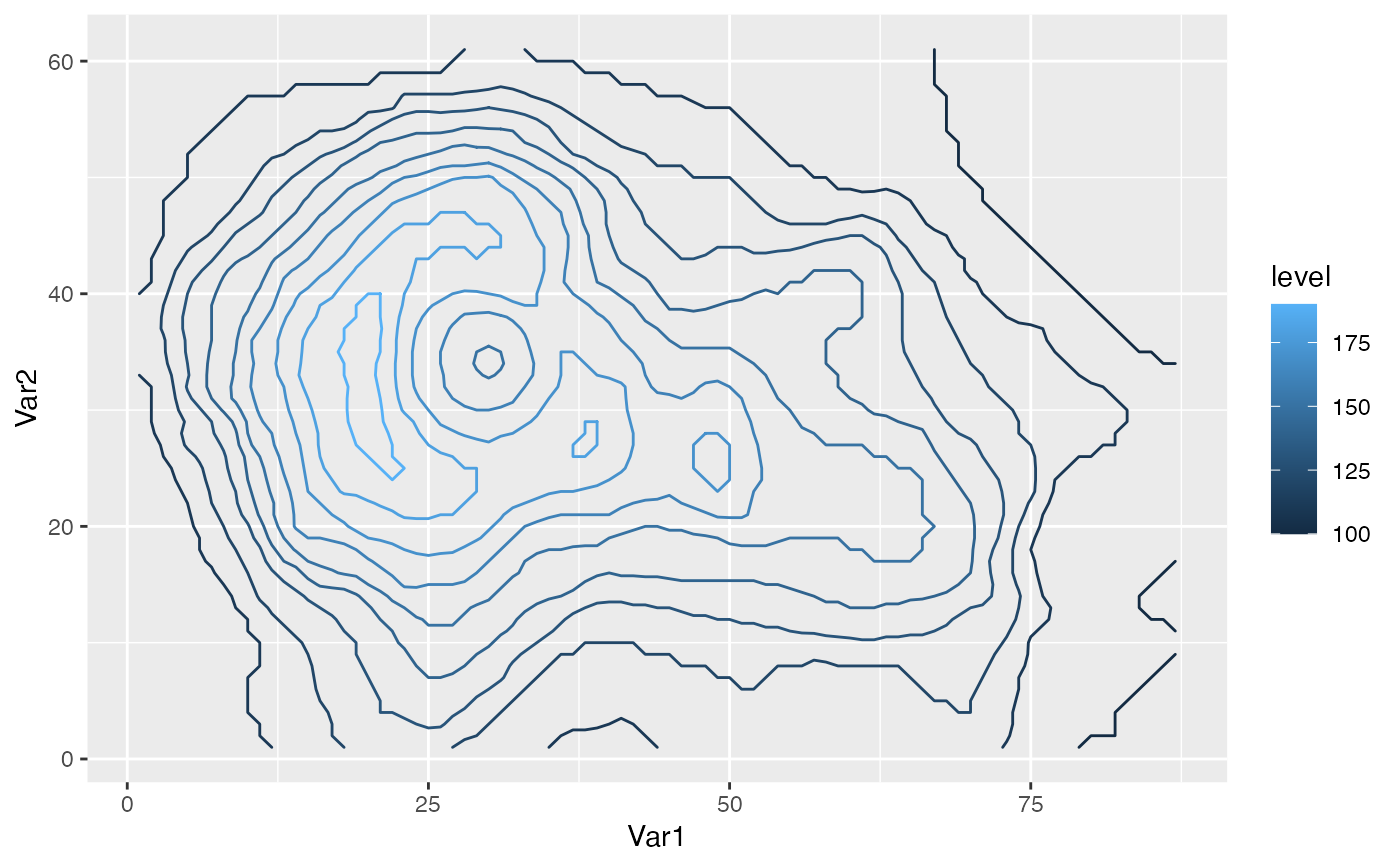 # Add labels by supplying the label aes.
ggplot(reshape2::melt(volcano), aes(Var1, Var2)) +
geom_contour2(aes(z = value, label = ..level..))
# Add labels by supplying the label aes.
ggplot(reshape2::melt(volcano), aes(Var1, Var2)) +
geom_contour2(aes(z = value, label = ..level..))
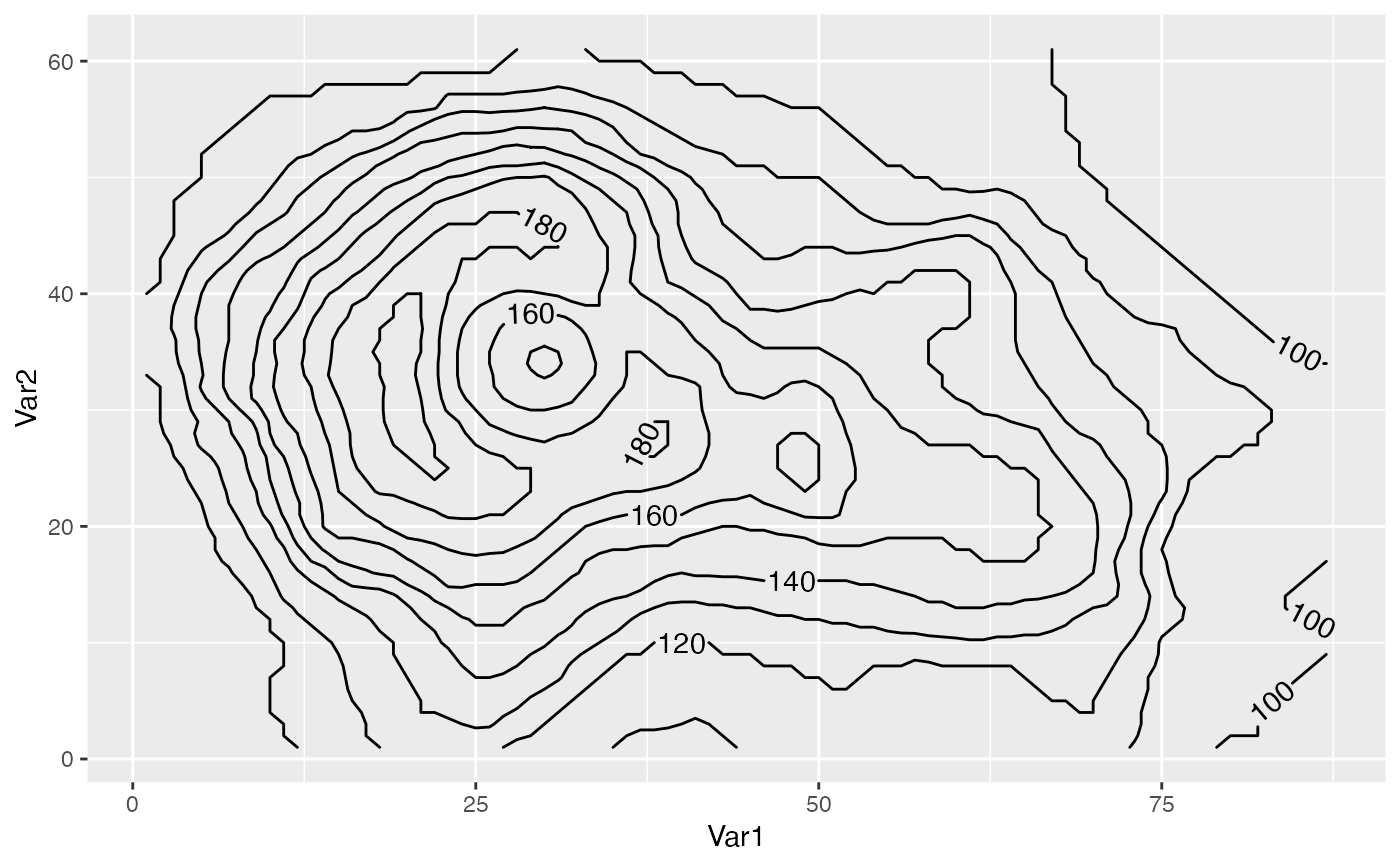 ggplot(reshape2::melt(volcano), aes(Var1, Var2)) +
geom_contour2(aes(z = value, label = ..level..),
skip = 0)
ggplot(reshape2::melt(volcano), aes(Var1, Var2)) +
geom_contour2(aes(z = value, label = ..level..),
skip = 0)
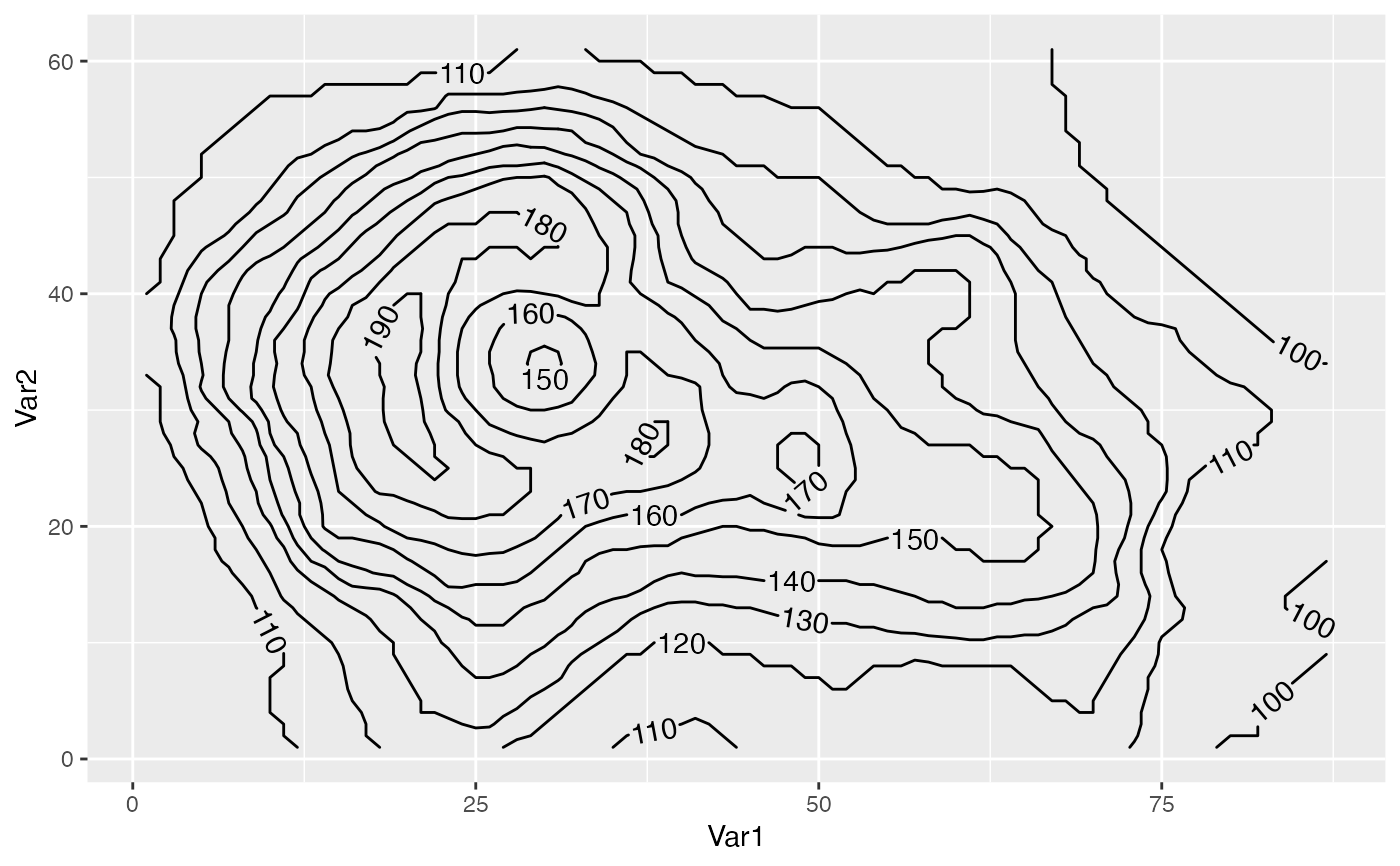 # Use label.placer to control where contours are labelled.
ggplot(reshape2::melt(volcano), aes(Var1, Var2)) +
geom_contour2(aes(z = value, label = ..level..),
label.placer = label_placer_n(n = 2))
# Use label.placer to control where contours are labelled.
ggplot(reshape2::melt(volcano), aes(Var1, Var2)) +
geom_contour2(aes(z = value, label = ..level..),
label.placer = label_placer_n(n = 2))
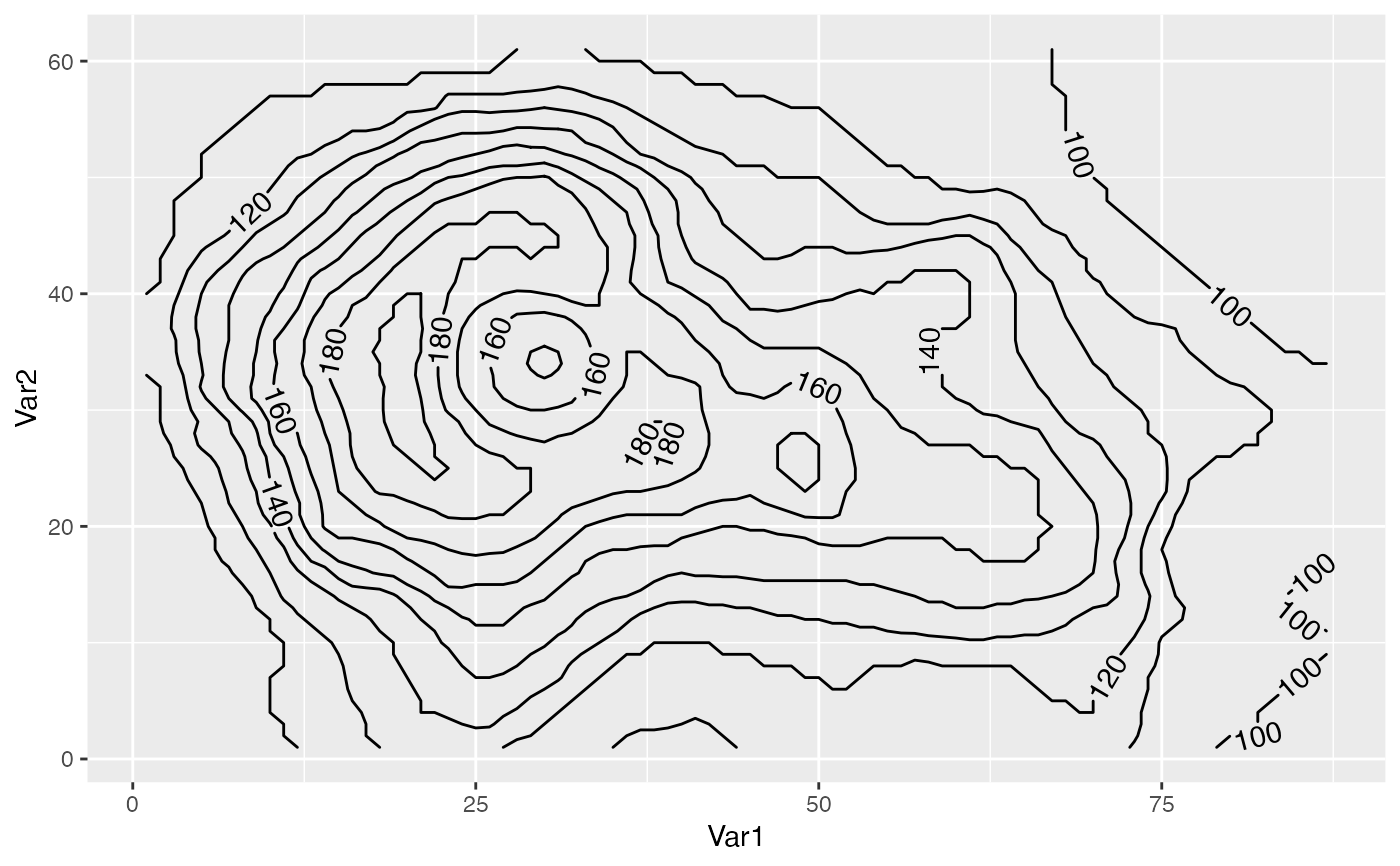 # Use the rot_adjuster argument of the placer function to
# control the angle. For example, to fix it to some angle:
ggplot(reshape2::melt(volcano), aes(Var1, Var2)) +
geom_contour2(aes(z = value, label = ..level..),
skip = 0,
label.placer = label_placer_flattest(rot_adjuster = 0))
# Use the rot_adjuster argument of the placer function to
# control the angle. For example, to fix it to some angle:
ggplot(reshape2::melt(volcano), aes(Var1, Var2)) +
geom_contour2(aes(z = value, label = ..level..),
skip = 0,
label.placer = label_placer_flattest(rot_adjuster = 0))
